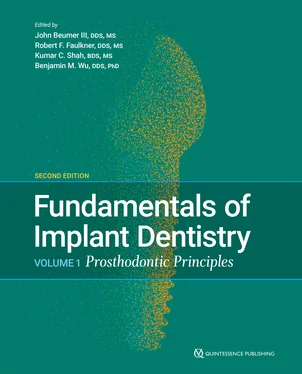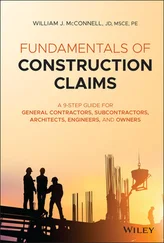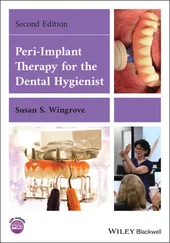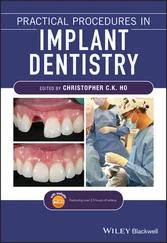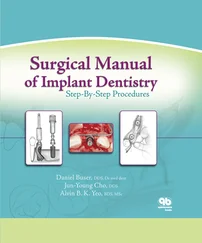• Which patients stand to benefit the most from implant therapy, and how do you identify them?
• Will mandibular implant-retained or -supported prostheses improve the masticatory function of all edentulous patients or just some of them?
• What are the success rates for various implant-based restorations for the edentulous maxilla and mandible?
• Does the nature of implant retention or support (eg, number of implants, types of attachment) impact oral function and patient satisfaction?
• Will the placement of osseointegrated implants prevent the natural processes of ridge resorption associated with denture use?
• Has this service become the validated treatment?
Resorption Patterns
Long-term denture use contributes to resorption of the edentulous mandible. 5– 7Denture use during sleeping hours is especially destructive, particularly if the patient presents with chronic bruxing and grinding habits. Furthermore, in the case of Kelly’s combination syndrome, 8the mucoperiosteum of maxillary anterior and mandibular posterior regions is compressed by occlusal forces and precipitates a resorptive remodeling response of the underlying bone.
The molecular mechanisms of compression force–derived residual ridge resorption have yet to be fully elucidated. Yeh and Rodan 9reported that the application of tensile forces to cells results in the secretion of stress-induced molecules such as prostaglandin E (PGE), a well-known inducer of bone resorption. Stress–induced PGE may also be involved in orthodontic tooth movement, where compression of periodontal ligament cells leads to production of PGE as well as other bone resorption–inducing molecules, resulting in resorption of alveolar bone. 10In an experimental model using edentulous rats, mandibular residual ridge resorption was shown to be regulated in part by PGE. The application of a cyclo- oxygenase inhibitor, blocking prostaglandin synthesis, effectively reduced bone resorption by up to 50%. 11Denture- induced residual ridge resorption hence may be explained by the mechanical stress-induced production of bone resorption mediators by the mucoperiosteum.
Following tooth extraction, bone resorption continues but at a reduced rate ( Fig 6-1). After Tallgren 12and Atwood 13reported this phenomenon, Carlsson and Persson 14documented its progression ( Fig 6-2) and showed that loss of mandibular bone height was most rapid during the first 6 to 8 months after tooth extraction, which was followed by continuous resorption but at a reduced rate. Carlsson and Persson 14also indicated that the rate of residual ridge resorption varies considerably among patients.

Fig 6-1 Continuous ridge resorption following tooth extraction. (a) Initial situation. (b) After 1 month. (c) After 3 months. (d) After 7 months. (e) After 17 years. (f) After 25 years.
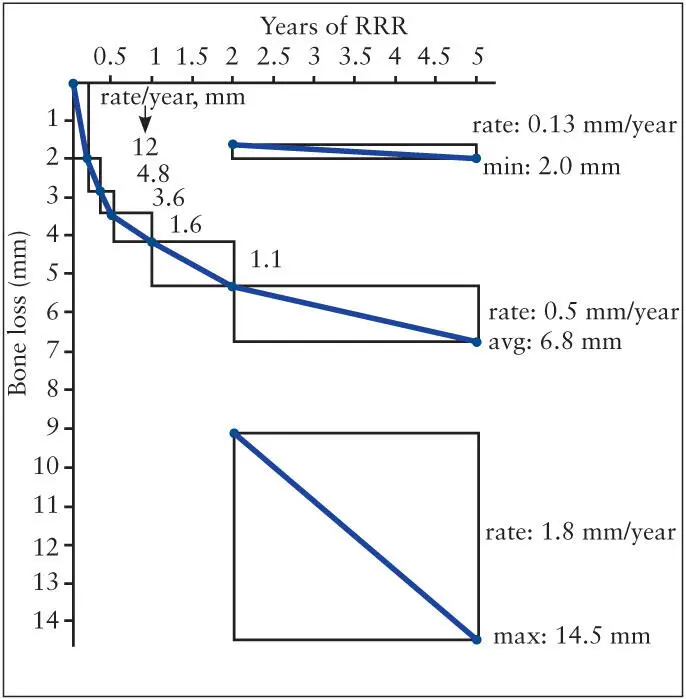
Fig 6-2 Residual ridge resorption (RRR). Min, minimum; avg, average; max, maximum. (Data from Carlsson and Persson. 14)
Since this observation, numerous studies have addressed the possible causes of excessive residual ridge resorption in select patients (for a review, see Jahangiri et al 15). These studies primarily addressed: (1) anatomical factors, ie, maxilla versus mandible; (2) prosthodontic factors, ie, monoplane teeth versus anatomical teeth; and (3) systemic factors, ie, osteoporosis. Approximately 30% to 40% of women in the United States develop postmenopausal osteoporosis, and many are edentulous. However, most studies examining the effect of osteoporosis (ie, reduced bone mineral index) and the loss of mandibular residual ridge height have repeatedly failed to find any. 7, 16– 18However, Nishimura et al 19reported that postmenopausal osteoporotic women appeared to maintain the height of the edentulous mandible but significantly lost its width, leading to the development of a “knife-edge” residual ridge ( Fig 6-3). The development of the “knife-edge” morphology was positively correlated with the loss of bone mineral density in cervical vertebral bones. Furthermore, clinical observations of patients with a knife-edge mandibular residual ridge revealed that there was a distinct undercut in the overlying oral mucosa, 20which was not evident in the flat residual ridge (see Fig 6-3). In addition, the edentulous maxilla of some osteoporotic patients exhibits severe bone resorption, 21with the ridge often covered by thin and highly stretched oral mucosa. Therefore, it is conceivable that systemic conditions associated with postmenopausal osteoporosis may affect oral mucoperiosteum remodeling and thus secondarily influence the pattern of residual ridge resorption.

Fig 6-3 Patients with osteoporosis tend to develop a knife-edge ridge with a mucosal undercut in the anterior region. (a) Typical resorption pattern. (b) Resorption pattern of an osteoporotic patient. Note the small maxilla and the knife-edge mandible. (c) Radiograph of a flat residual ridge. (d) Radiograph of a knife-edge residual ridge. (e) Intraoral view of a flat residual ridge. (f) Intraoral view of a knife-edge residual ridge.
Wound closure
Tooth extraction creates a sizable open wound in the oral cavity. While the bony socket is actively filled with newly formed alveolar bone and later remodeled, the gingival flaps undergo rapid contraction toward the center of the extraction socket ( Fig 6-4). Longitudinal observations in monkeys reveal that oral mucosa contraction occurred not only during the extraction wound healing but persisted throughout the experimental period of 6 months. 22As a result, the edentulous mucosa tightly adhered to the actively resorbing residual alveolar bone (see Fig 6-4). The tight adherence of overlying oral mucosa to the highly atrophied maxilla and mandible has been described by DeVan. 23

Fig 6-4 Rapid contraction of the extraction site after 7 days of healing. (a) Extraction site immediately after extraction. (b) Extraction site 1 week later.
Sukotjo et al 24isolated a novel gene from rat gingiva after tooth extraction wounding and called it wound-inducible transcript 3.0 or wit3.0 . The expression of wit3.0 in the oral mucosa was significantly activated by tooth extraction in animals 24as well as in humans, 25and the high level of wit3.0 expression appeared to continue after initial healing of the extraction site. Wit3.0 is a small cytoskeleton molecule also called fibroblast growth factor receptor 1 oncogene partner 2 (FGFR1OP2) that contributes to the fibroblast-derived tissue contraction in vitro 26and in vivo. 27The wound- induced overexpression of FGFR1OP2/wit3.0 appeared to be a unique phenomenon for oral mucosa. For example, full-thickness open wounds created in mouse skin do not significantly induce its expression. Therefore, it has been postulated that the wound-induced synthesis of FGFR1OP2/wit3.0 is unique to the oral mucosa and facilitates the rapid wound closure after tooth extraction.
Читать дальше
